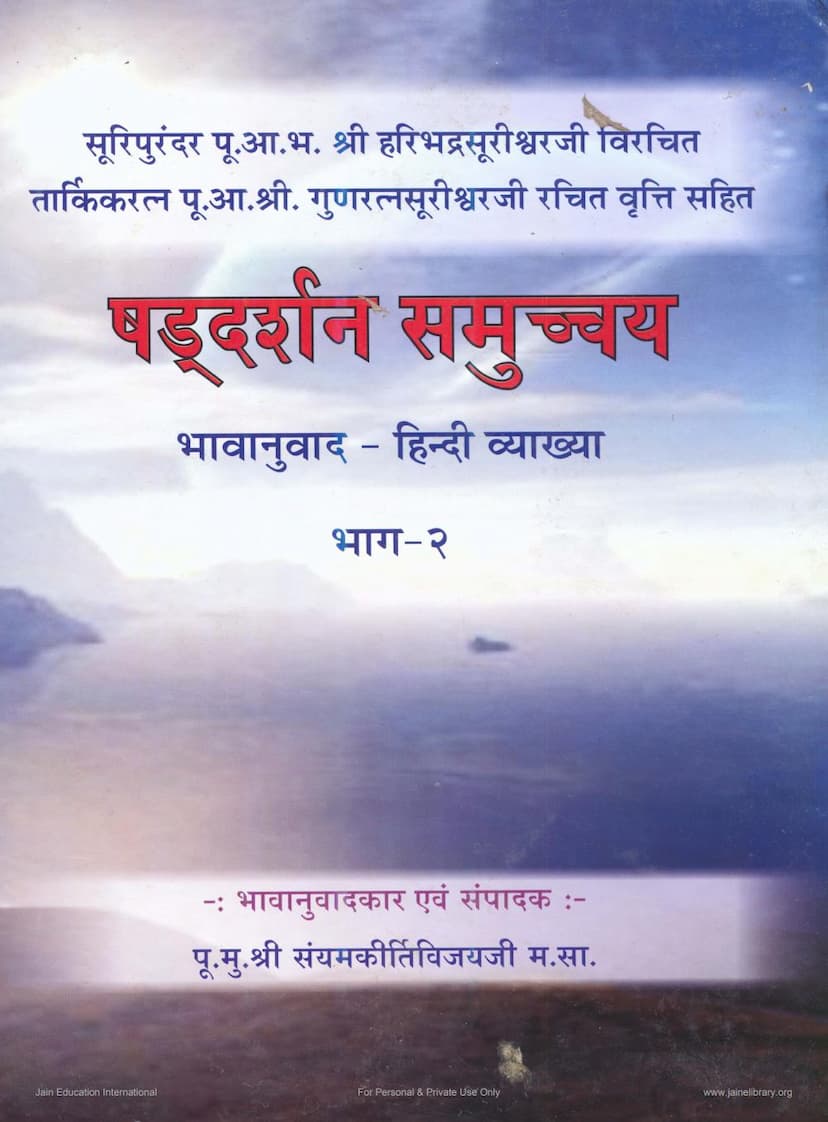Shaddarshan Samucchaya Part 02
Added to library: September 2, 2025

Summary
Here's a comprehensive summary of the Jain text "Shaddarshan Samucchaya Part 02" by Sanyamkirtivijay:
Overview:
"Shaddarshan Samucchaya Part 02" is a detailed commentary and Hindi interpretation (Bhavanuvaad) of the foundational Jain text "Shaddarshan Samucchaya" by Acharya Haribhadrasuri, with an extensive commentary by Acharya Gunaratnasuri. This second part, compiled and edited by Muni Sanyamkirtivijay, focuses on presenting and analyzing various philosophical schools (Darshanas) from a Jain perspective. It aims to make this complex philosophical heritage accessible to a wider audience through its Hindi explanation.
Key Figures:
- Acharya Haribhadrasuri: The original author of "Shaddarshan Samucchaya," a renowned Jain scholar and philosopher.
- Acharya Gunaratnasuri: The commentator whose insightful explanations are elaborated upon.
- Muni Sanyamkirtivijay: The compiler and translator who has provided the Hindi interpretation and edited the text.
- Acharya Vijay Ramchandra Surishwarji Maharaj: His "Diksha Smriti Din Shatabdi Varsh" (centenary of his initiation) is dedicated to this publication, highlighting his significant role in promoting Jain scriptures.
Content Summary (Based on the provided pages, which outline the structure and key topics):
The book is a comprehensive exploration of various Indian philosophical systems (Shaddarshan - Six Darshanas), critically examined and explained through the lens of Jain philosophy. Part 2 appears to delve into specific schools and their core tenets, often contrasting them with Jain principles.
The structure indicates coverage of:
- Jain Philosophy: A dedicated section likely provides an in-depth exposition of Jain principles, possibly as a comparative foundation.
- Buddhist Philosophy: This section would detail the key doctrines of Buddhism, such as anattavada (non-self), kshana-vada (momentariness), pratitya-samutpada (dependent origination), and anishwaravada (atheism). It would likely analyze Buddhist epistemology (pramana vichar).
- Naiyayika Darshana (Logic/Nyaya School): This part would cover the Nyaya school's emphasis on logic, its theory of knowledge (pramana vichar - direct perception, inference, analogy, testimony), its metaphysical principles, and its concept of deities.
- Sankhya Darshana: This section would focus on Sankhya's dualistic philosophy, its concept of Prakriti and Purusha, the theory of causality (Shatkaryavada), and its epistemological principles. It would likely include a detailed explanation of its metaphysical tenets.
- Vaisheshika Darshana: This school's atomistic and realist philosophy, its explanation of categories (padarthas) like substance (dravya), quality (guna), action (karma), universal (samanya), particular (vishesha), and inherence (samavaya), its theory of perception, and its concept of God would be covered.
- Mimamsaka Darshana: This section would likely focus on the Mimamsa school's emphasis on Vedic ritual, its theory of language, its epistemology (pramanas), and its rejection of a creator God (Anishwaravada). It might also touch upon the Vedantic aspect.
Key Themes and Analytical Approach:
- Comparative Philosophy: The text systematically presents and then analyzes various philosophical viewpoints, likely highlighting their similarities, differences, and potential inconsistencies, particularly in relation to Jainism.
- Epistemology (Pramana Vichar): A significant portion seems dedicated to understanding how each school acquires knowledge, the validity of their means of knowledge, and how these compare to the Jain theory of knowledge (Anekantavada, Syadvada).
- Metaphysics and Ontology: The core principles regarding the nature of reality, the existence of God or deities, the concept of soul (Atman), causality, and the ultimate goal of existence (Moksha) are likely discussed and debated.
- Critique from a Jain Standpoint: The work is not merely a descriptive presentation but also a critical examination of other philosophies from the foundational principles of Jainism, likely aiming to demonstrate the superiority or unique validity of the Jain perspective.
- Accessibility: The "Bhavanuvaad" (interpretive translation) in Hindi aims to make these often-dense philosophical discussions understandable to a broader audience, bridging the gap between original Sanskrit/Prakrit texts and modern readers.
Overall Purpose:
The "Shaddarshan Samucchaya" (and this second part) serves as a vital resource for understanding the diverse philosophical landscape of ancient India and, importantly, for understanding how Jain philosophy engaged with and critically analyzed these other traditions. It reinforces the comprehensive and nuanced approach of Jainism to understanding reality. The dedication to the centenary year of Acharya Vijay Ramchandra Surishwarji Maharaj signifies the work's importance within the Tapa Gaccha tradition and its commitment to preserving and propagating knowledge.